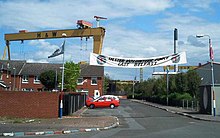Harland & Wolff
| Harland and Wolff Heavy Industries Ltd | |
|---|---|
| legal form | Limited |
| founding | 1851 |
| Seat | Belfast , Northern Ireland |
| management | Jonathan Guest, CEO |
| Number of employees | 123 |
| Branch | shipbuilding |
| Website | www.harland-wolff.com |
| Status: 2019 | |

Harland & Wolff Ltd. is a shipyard in Belfast , Northern Ireland . She was (during the heyday of steamship line English ocean liner ) one of the most important shipyards in Europe and employed 30,000 people. After filing for bankruptcy in August 2019, it was acquired by a London-based energy company in December of that year .
history
The first forerunner of the world-famous shipyard was founded in 1851 by Thompson & Kirwan to build wooden ships . In 1853 Robert Hickson started a company to build iron ships. In 1854, Edward James Harland (1831–1895, later Sir Edward J. Harland) from Newcastle upon Tyne (England) took over the management of the Hickson shipyard and in 1858 became its owner.
He received financial support from Gustav Christian Schwabe , the junior partner of John Bibby, Sons & Co. Ltd. , Liverpool . This awarded the contract for three large ships ( Venetian 1859, Sicilian 1860, Syrian 1860) to EJ Harland. In order to cope with the follow-up orders from a total of fifteen other sailing steamers ( Grecian , Italian , Egyptian , Dalmatian , Arabian etc.), the German engineer Gustav Wolff , nephew of Gustav Christian Schwabe, officially joined the company as a partner on January 1, 1862 and thus established the company the Harland & Wolff Ltd shipyard .
It was also Gustav Christian Schwabe who got Thomas Henry Ismay , founder of the White Star Line , to order the ships for his shipping company from Harland & Wolff . This created a very fruitful partnership. The rise of the shipyard was closely related to that of the White Star Line. Although there were no written contractual provisions between the two partners, Harland & Wolff did not build for any direct White Star competitor and the shipping company for its part only ordered newbuildings from the Northern Irish. The most famous ships of the White Star Line , which were built on the helm of the shipyard, were the Olympic class with the Titanic and its two sister ships RMS Olympic and HMHS Britannic .

In the period that followed, similar partnerships were established with other British shipping companies that were large and successful at the time. The Royal Mail Line , Pacific Steam Navigation Company , P & O Lines , Union-Castle Line , Bibby Line or Shaw, Savill & Albion Steamship Co. only ordered or most of their newbuildings from Harland & Wolff . Foreign shipping companies such as Holland-Amerika Lijn were also among the most loyal customers. In order to cope with the flood of construction contracts, a branch was even opened in Govan, Scotland .
Harland & Wolff also carried out regular orders for the British Navy, the Royal Navy . During the two world wars, countless of the many types of standard freighters were built at the shipyard.
In the 1960s and 1970s the economic problems began for the shipyard. There was a shipyard crisis in many western industrialized countries . Aircraft , containers , the collapse of the Empire and other factors created a crisis in the UK shipping industry. Many shipping companies gave up because they lost their liner services or did not want or could not convert their fleets to containers. Harland & Wolff was incorporated into the British Shipbuilders Corporation in 1977 and privatized again in 1983. At the end of the 1980s, the Norwegian company took over Fred. Olsen Energy has a majority stake in the yard.
The shipyard survived the crisis at the end of the 20th century; Since then, she has not been able to bring her experience in the construction of luxury liners to new builds. The main business today is the repair and overhaul of ships, occasionally building new ones for civil clients or the Royal Navy . Harland & Wolff also carried out renovation work on the famous Ha'penny Bridge in Dublin, which was awarded the Europa Nostra Prize for valuable preservation work on cultural property in 2003.
Most recently, the shipyard, which had shrunk to just 123 employees, was mainly involved in the construction of wind turbines and other marine engineering projects. After major losses were written over a long period of time, Harland & Wolff filed for bankruptcy on August 5, 2019. The last owner, the Norwegian company Dolphin Drilling, was no longer able to support them financially. The company was already up for sale anyway. In December 2019, Harland and Wulff was acquired by London-based InfraStrata for £ 4.75 million . The company is active in the energy sector and intends to continue its new location in Belfast initially to build structures for its projects.
Web links
Individual evidence
- ^ Appointment of new CEO. Press release. Harland & Wolff, April 26, 2018, accessed September 22, 2018 .
- ^ Margaret Canning: Harland & Wolff for sale as Norwegian owner Fred Olsen instigates restructuring process. Belfast Telegraph, December 21, 2018, accessed June 30, 2019 .
- ↑ Philip Plickert, London: Co- founded by the German: The Titanic shipyard files for bankruptcy . ISSN 0174-4909 ( faz.net [accessed August 6, 2019]).
- ^ Clodagh Rice: Harland and Wolff deal completed by new owner InfraStrata. BBC , December 5, 2019, accessed the same day. (English)
Coordinates: 54 ° 36 '37.9 " N , 5 ° 54' 2.5" W.
